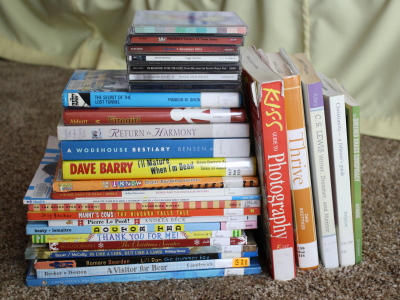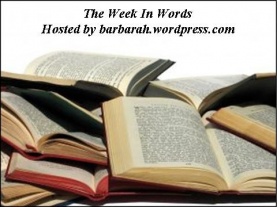In a fit of I-don’t-exactly-know-what, I broke my 100 item rule at the library and checked out 114 items on April 30 (a week an a half after showing you the picture below–what I still had to finish in that last week’s time.)

A week later (after checking out the 114 books), my library switched its catalog over to a different format–one that automatically notifies borrowers via e-mail that their books are almost due.
So 18 days after checking out those 114 library books (for the three week renewal period), I arrived home to find…
114 notification emails in my email inbox.
The pre-notification system is great and all–but couldn’t they just combine all the books due into ONE email?
Anyway, enough about that–you want to know what I read this month.
This month I read:
At Home: A Short History of Private Life by Bill Bryson
I planned to review this one in more detail. My plans went awry. So, here’s what I wrote in my journal to jog my memory for a more full review (the jotted notes were necessary since this was among the books that went BACK to the library on the 30th of April): “short not best descriptor-meandering perhaps. through rooms of Bryson’s own English home–formerly a vicarage. servants, plumbing, architecture, gardening, glass, iron vs. steel, a little archeology–seamless flow through diverse topics–modern disease, food habits, bathing habits, styles of clothing, class distinction. Enjoyable, but at 452 pages, not exactly short.”
Bones and the Big Yellow Mystery by David Adler
A Children’s First Reader, this title wasn’t near as impressive as the Cam Jansen series, also by David Adler. This particular story was all about “Bones” a kid detective who solves a mystery of a missing bus (Turns out the bus driver had exited the wrong door in the mall and gotten scared when he didn’t see his bus nearby.) The story could have been good, except that the story doesn’t give the right sort of clues to allow the reader to try to solve the mystery on his own (which, I think, is the key to any sort of mystery–even for beginning readers!)
Boogers are my Beat by Dave Barry
Dave Barry is always amusing. This particular book, so far as I can tell, is a collection of columns from 2000 and 2001–which means that it covers, among other things, the Democratic and Republican conventions, the recount debacle, and September 11. Generally amusing, this pokes fun equally at left and right–and includes some nice non-political pieces as well.
Cam Jansen and the Mystery of the Television Dog by David Adler
As I alluded earlier, I do like these Cam Jansen stories. They’re beginner’s chapter books that star “Cam” Jansen (short for “Camera”), a youngster with a photographic memory. In this particular story, a dog-napper steals a celebrity pooch in the midst of said celebrity’s book signing event. These stories are simple to read and fairly straightforward as far as mysteries go–but are still amusing and likely to be quite fun for the target audience.
GraceLand by Chris Abani
I chose not to return this one to the library just yet, because I intend to review it in more depth. This is the story of a young black Elvis impersonator in Nigeria. The story reminded me somewhat of Slumdog Millionaire. It was brutal, violent, and often unpleasant–but somehow ended up being a remarkably moving story.
Nim at Sea by Wendy Orr
I checked this out expecting it to be the book off of which Nim’s Island (the movie) was based. I got it home to discover that this was in fact the sequel to Nim’s Island (the book off of which the movie was based.) Turns out, this is a delightful little tale of how Nim “forces” the author off the island in a fit of bad manners–and then goes stowaway to retrieve her in a fit of compassion for her now-lonely dad (Oh, and to retrieve her pet seal, who has been poached by an evil tour-cruise company.) A delightful little novel just right for the middle-grade audience (and for myself).
Room for Improvement by Stacey Ballis
Remember Trading Spaces, the TLC home makeover show that was all the hit a half dozen years ago or so? Now imagine Trading Spaces with a personal makeover twist. Single guy (with the help of an interior designer) makes over single gal’s house (to make it more “guy friendly”)–then gets made over himself (by a gay fashionisto/a, of course), just in time for an unveiling in which he meets said single gal. And vice versa. Our heroine, if you can call her that, is one of the interior designers. This fits squarely into the chick lit genre, with all the accompanying drama (including some affairs, be forewarned). I found the setting amusing (since I was in college and had access to a TV during the “Trading Spaces” craze), but the story somewhat lacking. Eh.
The Rose and the Beast by Francesca Lia Block
Modern retellings of a number of fairy tales, all in short story form. Block is definitely a YA author, with all the accompanying shock value. These stories include rape, incest, homosexuality, violence, teenage runaways, you name it. She’s a masterful tale-teller, but definitely into the dark side of things.
Spoken from the Heart by Laura Bush
I’ve decided that either Laura or her ghostwriter (Lyric Winik) is a lovely writer. I enjoyed the anecdotes in this book, as well as the way in which they were told. Laura’s voice is inherently nice, even when she’s talking about things that aren’t always nice. Even when she’s issuing reprimands to reporters or public figures who spoke unfairly of her or her husband, the reprimand is not shrill or accusatory. I greatly enjoyed reading the former first lady’s perspective on her own life (from her earliest years to the first year after the White House–naturally the eight years in the White House occupy a good bit of the narrative). This wasn’t an exceptional memoir (nor was it the “finish in one setting, almost chick lit” like so many these days)–but it was a nice look at Laura’s life.
The Story of the Bible by Larry Stone
I reviewed this title at length, subtitling it “A Museum in a Book”. It’s the story of the writing, preservation, copying, and translation of the Bible–including full size reproductions of dozens of manuscripts. I loved it.
Time for Kids 2009 Almanac
I love almanacs, and I enjoyed this one. But when I find a half-dozen mistakes in the nutrition section, I wonder what else Time got wrong.
Tomorrow’s Dream by Janette Oke and T. Davis Bunn
The sequel to Another Homecoming, which I wrote about in my last nightstand post. The young heroine of the previous novel is now faced with a tragedy that shakes her to her core: the death of her infant son. Another engaging story with eternal hope from Janette Oke (and T. Davis Bunn, who I am much less familiar with than I am with Oke.)
Children’s Books, authors Bechtold-Berenstain (50 or 60 titles)
Also read:
- The Biggest Loser (reviewed here)
- The Garden of Eden by Ernest Hemingway (reviewed, of a sort, here)
- Now, Discover Your Strengths by Buckingham and Clifton of Gallup
- The Penguin Historical Atlas of the Third Reich
- World War II by Mike Sharpe
The 114 items checked out (and a few more purchased along the way) have whittled themselves down to these, in progress:

And these, in the wings:

Don’t forget to drop by 5 Minutes 4 Books to see what others are reading this month!









